
A Profile Head of the King, based on a design by Bertram Mackennal, replaced the Downey Head design in 1912. The first rolls containing these stamps were issued in August 1913.
Profile Head stamps were printed in letterpress by Harrison on paper with a Royal Cypher watermark. There are two types of Royal Cypher: Multiple Cypher and Simple Cypher, both illustrated above. In 1924 the printing contract changed to Waterlow and the watermark was changed to a Block Cypher.
The period from 1913 to 1924 not only spanned the First World War, but saw many changes in the rolls, which included changes in watermark, leader and tail papers. The minimum Inland Letter Rate increased from 1d to 1½d in 1918, then to 2d in 1920, which resulted in new rolls of these values, then the rate was reduced back to 1½d in 1922.
Rolls of 480 were introduced for sideways delivery in 1920 (made from horizontal strips of 12 stamps, 500 does not divide evenly by 12, hence 480), and experiments in continuous printing produced continuous (E) rolls in 1921.
Profile Head — Multiple Cypher
The first rolls of profile head stamps were issued in August 1913 on Multiple Cypher paper. Only (E) and (G) rolls were issued, both without a printer’s imprint. These were for FIXO, the most popular stamp affixer at the time.
The British Philatelist [6(7)50] Sept 1913 said:
These lowest two values, on the Multiple paper, are printed in the usual sheets, with control “C 13”. They are intended for Rolls only, being printed on this paper because it is especially tough, and more adapted for this particular use than is that with the “single” or “simple” watermark.
but as Simple Cypher followed in November perhaps the printer was simply using up surplus paper stock.
| E | 1d | 500 | £2.1.9 | Top End | Buff | 10 |
| G | ½d | 500 | £1.0.11 | Top End | Buff | 10 |

Perforated tails printed with “JOINED BY …” and “DATE …”:

1d dated 31/6/13 ½d dated 19/6/13
The following census of Multiple Cypher tails shows they were produced over a two-month period from Friday 2.5.13 to Tuesday 8.7.13. The latest known Downey Head tail is dated 1.5.13, the day before the first Multiple Cypher. The earliest known Simple Cypher tail is dated Tuesday 15.7.13, a week after the last Multiple Cypher.
| ½d | 41 | 2.5.13 | Fri |
| ½d | 180 | 3.5.13 | Sat |
| ½d | 117 | 3.5.13 | Sat |
| 1d | 103 | 7.5.13 | Wed |
| 1d | — | 8.5.13 | Thu |
| ½d | 117 | 14.5.13 | Wed |
| 1d | 86 | 14.5.13 | Wed |
| ½d | 117 | 16.5.13 | Fri |
| 1d | 58 | 20.5.13 | Tue |
| 1d | 92 | 20.5.13 | Tue |
| ½d | 103 | 23.5.13 | Fri |
| ½d | 180 | 23.5.13 | Fri |
| 1d | — | 24.5.13 | Sat |
| ½d | 103 | 27.5.13 | Tue |
| 1d | 103 | 27.5.13 | Tue |
| 1d | 58 | 27.5.13 | Tue |
| 1d | 92 | 29.5.13 | Thu |
| 1d | 103 | 29.5.13 | Thu |
| 1d | 117 | 6.6.13 | Fri |
| ½d | 92 | 9.6.13 | Mon |
| 1d | 103 | 9.6.13 | Mon |
| ½d | 60 | 19.6.13 | Thu |
| ½d | 103 | 20.6.13 | Fri |
| 1d | 60 | 23.6.13 | Mon |
| — | 180 | 26.6.13 | Thu |
| 1d | 103 | 31.6.13 | Mon |
| 1d | 103 | 2.7.13 | Wed |
| 1d* | 117 | 2.7.13 | Wed |
| 1d | 109 | 2.7.13 | Wed |
| ½d | 117 | 7.7.13 | Mon |
| 1d | 117 | 8.7.13 | Tue |
* this tail is known with control “C 13” in the margin.
Profile Head — Simple Cypher
The full range or rolls from (A) to (H) was issued from November 1913 on Simple Cypher paper.
| A | 1d | 1,000 | £4.3.6 | Top End | Buff | 10 |
| B | 1d | 1,000 | £4.3.6 | Lower End | Buff | 10 |
| C | ½d | 1,000 | £2.1.10 | Top End | Buff | 10 |
| D | ½d | 1,000 | £2.1.10 | Lower End | Buff | 10 |
| E | 1d | 500 | £2.1.9 | Top End | Buff | 10 |
| F | 1d | 500 | £2.1.9 | Lower End | Buff | 10 |
| G | ½d | 500 | £1.0.11 | Top End | Buff | 10 |
| H | ½d | 500 | £1.0.11 | Lower End | Buff | 10 |
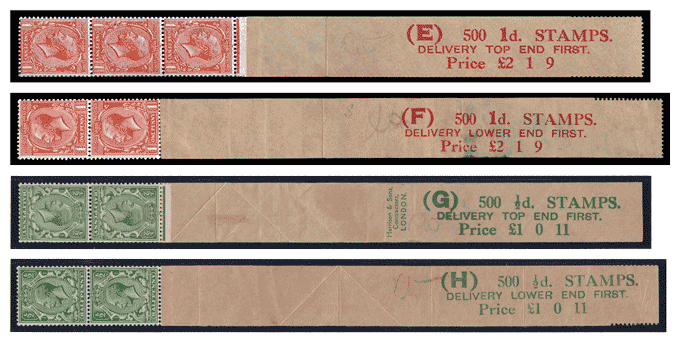
The printer’s imprint “Harrison & Sons, Contractors, LONDON.” was added from the end of 1914. Leaders exist with and without the imprint.
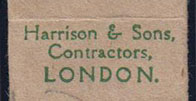
Tails were initially made from buff paper but yellow was also used from 1914, orange from 1919, and several different colours in later years.
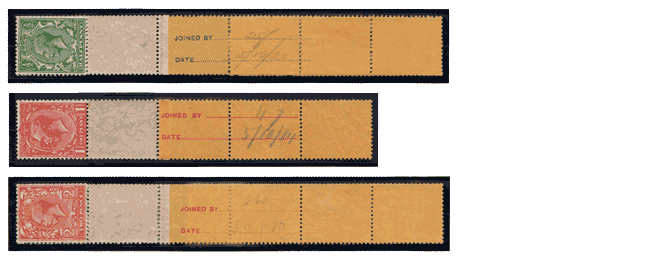
½d dated 15/12/20 1d dated 5/10/14 2d dated 30/7/20
Increased Postal Rate — 1½d
The minimum Inland Letter Rate was increased from 1d to 1½d on 3 June 1918. Four new 1½d rolls were announced, one for each of the four types of affixer. Initially these were printed at face value in error.
| J | 1½d | 1,000 | £6.5.0 | Top End | Buff | 10 |
| K | 1½d | 1,000 | £6.5.0 | Lower End | Buff | 10 |
| L | 1½d | 500 | £3.2.6 | Top End | Buff | 10 |
| M | 1½d | 500 | £3.2.6 | Lower End | Buff | 10 |
All face value leaders were amended in manuscript before issue; however, at least one (J) leader exists without amendment. Later printings were corrected to include the handling charge.

| J | 1½d | 1,000 | £6.5.2 | Top End | Buff | 10 |
| K | 1½d | 1,000 | £6.5.2 | Lower End | Buff | 10 |
| L | 1½d | 500 | £3.2.7 | Top End | Buff | 10 |
| M | 1½d | 500 | £3.2.7 | Lower End | Buff | 10 |
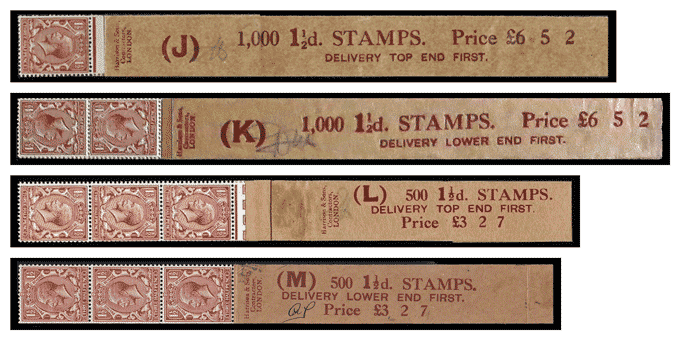
Increased Postal Rate — 2d
The minimum Inland Letter Rate was increased from 1½d to 2d on 1 June 1920. The handling charge was also increased from 1d to 2d per 500 stamps on the same date. Existing rolls were amended in manuscript, adding 1d to rolls of 500, and 2d to rolls of 1,000.
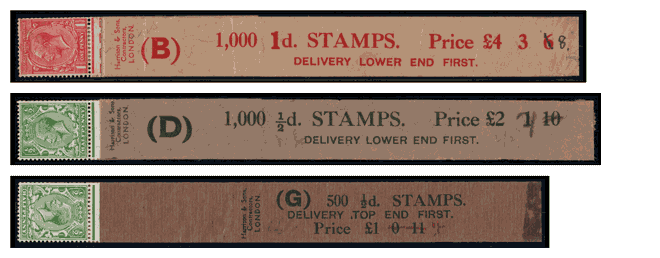
(B): £4.3.6 to £4.3.8 (D): £2.1.10 to £2.2.0 (G): £1.0.11 to £1.1.0
| A | 1d | 1,000 | £4.3.8 | Top End | Buff | 10 |
| B | 1d | 1,000 | £4.3.8 | Lower End | Buff | 10 |
| C | ½d | 1,000 | £2.2.0 | Top End | Buff | 10 |
| D | ½d | 1,000 | £2.2.0 | Lower End | Buff | 10 |
| E | 1d | 500 | £2.1.10 | Top End | Buff | 10 |
| F | 1d | 500 | £2.1.10 | Lower End | Buff | 10 |
| G | ½d | 500 | £1.1.0 | Top End | Buff | 10 |
| H | ½d | 500 | £1.1.0 | Lower End | Buff | 10 |
| J | 1½d | 1,000 | £6.5.4 | Top End | Buff | 10 |
| K | 1½d | 1,000 | £6.5.4 | Lower End | Buff | 10 |
| L | 1½d | 500 | £3.2.8 | Top End | Buff | 10 |
| M | 1½d | 500 | £3.2.8 | Lower End | Buff | 10 |

At the same time, rolls of 1,000 for top end delivery (ACJ) were discontinued as stocks were exhausted, and no equivalent 2d roll was issued. With the Michelius machine out of the running, there were therefore only three new 2d rolls announced, one for each of the remaining three types of affixer.
| Q | 2d | 1,000 | £8.7.0 | Lower End | Buff | 10 |
| R | 2d | 500 | £4.3.6 | Top End | Buff | 10 |
| S | 2d | 500 | £4.3.6 | Lower End | Buff | 10 |

Sideways Delivery
For some years the Merkham Trading Co had been asking the Post Office for sideways delivery rolls. In January 1920, a warrant was issued for 480 rolls of 500 stamps each, but 500 doesn’t divide by 12, so Harrison suggested 500 rolls of 480 stamps instead. Three of these (N) rolls were delivered to the Merkham Trading Co in February 1920 for testing in Multipost affixing machines.
| N | 1½d | 480 | £3.0.1 | Right Side | Buff | 12 |
The tests were successful, except that rolls were to be left side delivery, not right side, and further (N) rolls were issued, followed by (OPT) rolls in August.
| N | 1½d | 480 | £3.0.2 | Left Side | Buff | 12 |
| O | 1d | 480 | £2.0.2 | Left Side | Buff | 12 |
| P | ½d | 480 | £1.0.2 | Left Side | Buff | 12 |
| T | 2d | 480 | £4.0.2 | Left Side | Buff | 12 |

As a result, Merkham changed the Multipost affixer from vertical to horizontal deliver, and hence all rolls of 500 for lower end delivery (FHMS) were discontinued, although some remained in stock until 1928. By the mid-1920s the Multipost affixer dominated the market.
Coloured Leaders
From February 1921 leader paper was changed to be the same colour as the stamps, ½d green, 1d red, and 2d orange, with the text printed in black. The 1½d rolls (KLN) were unchanged with brown printing on buff. Coloured leaders were issued as stocks of the buff leaders were exhausted. Rolls of 1,000 for top end delivery (ACJ) and rolls of 500 for lower end delivery (FHMS) were discontinued.
| B | 1d | 1,000 | £4.3.8 | Lower End | Red/White | 10 |
| D | ½d | 1,000 | £2.2.0 | Lower End | Green/White | 10 |
| E | 1d | 500 | £2.1.10 | Top End | Red/White | 10 |
| G | ½d | 500 | £1.1.0 | Top End | Green/White | 10 |
| O | 1d | 480 | £2.0.2 | Left Side | Red/White | 12 |
| P | ½d | 480 | £1.0.2 | Left Side | Green/White | 12 |
| Q | 2d | 1,000 | £8.7.0 | Lower End | Orange/White | 10 |
| R | 2d | 500 | £4.3.6 | Top End | Orange/White | 10 |
| T | 2d | 480 | £4.0.2 | Left Side | Orange/White | 12 |
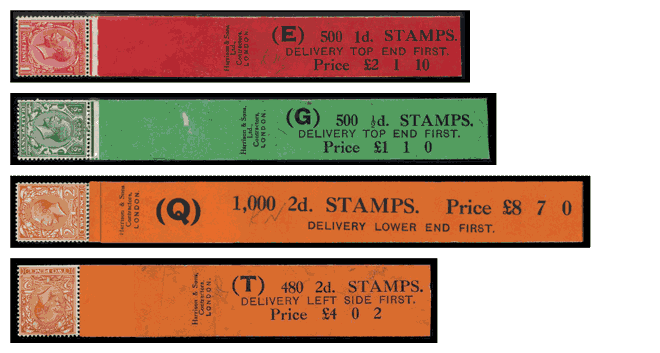
The printer’s imprint on some rolls was expanded to four lines, with “Ltd.” added.
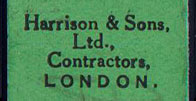
Continuous Printing
Trials for continuous printing of rolls began in 1913 at Somerset House and continued into 1915 but then stopped because of the war and lack of success. Trials restarted in 1920 and the results were good enough that in 1921 rolls were tested in various affixing machines. Testing went well and in November 1921 the 530 (E) rolls on hand were issued. Then in March 1922 a warrant was issued for 10,000 (E) rolls for issue, followed by a warrant in May 1923 for 12,000 (E) rolls.
| E | 1d | 500 | £2.1.10 | Top End | Red/White | c |

The leader colour is a darker red than the Harrison (E) rolls and does not have a printer’s imprint.
Reduced Postal Rate — 1½d
The minimum Inland Letter Rate was reduced from 2d back to 1½d on 29 May 1922. This did not cause any change in roll production but did reduce the demand for 2d rolls (and for the experimental 3s booklets with 18 x 2d stamps). Unsold (QRT) rolls were returned to the Post Office Stores and held in stock, unsold booklets were destroyed, and unsold 2d Kermode rolls were issued to Postmasters for over-the-counter sales.
Rolls for use in Ireland
British stamps were not valid in Southern Ireland from 1 April 1922, but it wasn’t until June 1922 that rolls overprinted by Harrison for use in Ireland were issued, initially with a 5-line overprint, then a 3-line overprint from December 1922.

5-line & 3-line overprints
5-line overprint “Rialtas/Sealadach/na/hÉireann/1922” (Provisional Government of Ireland 1922). All rolls except (K) were produced.
| B | 1d | 1,000 | £4.3.8 | Lower End | Red/White | 10 |
| D | ½d | 1,000 | £2.2.0 | Lower End | Green/White | 10 |
| E | 1d | 500 | £2.1.10 | Top End | Red/White | 10 |
| G | ½d | 500 | £1.1.0 | Top End | Green/White | 10 |
| L | 1½d | 500 | £3.2.8 | Top End | Buff | 10 |
| N | 1½d | 480 | £3.0.2 | Left Side | Buff | 12 |
| O | 1d | 480 | £2.0.2 | Left Side | Red/White | 12 |
| P | ½d | 480 | £1.0.2 | Left Side | Green/White | 12 |
| Q | 2d | 1,000 | £8.7.0 | Lower End | Orange/White | 10 |
| R | 2d | 500 | £4.3.6 | Top End | Orange/White | 10 |
| T | 2d | 480 | £4.0.2 | Left Side | Orange/White | 12 |
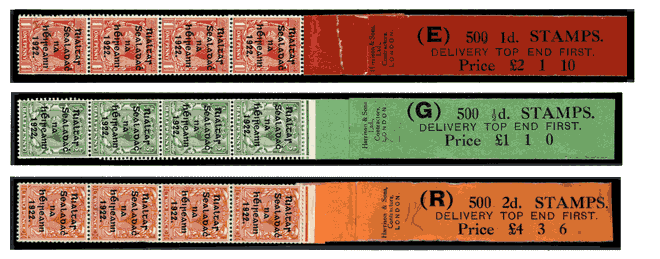
3-line overprint “Saorstát/Éireann/1922” (Irish Free State 1922).
| E | 1d | 500 | £2.1.10 | Top End | Red/White | 10 |
| G | ½d | 500 | £1.1.0 | Top End | Green/White | 10 |
| L | 1½d | 500 | £3.2.8 | Top End | Buff | 10 |
| N | 1½d | 480 | £3.0.2 | Left Side | Buff | 12 |
| O | 1d | 480 | £2.0.2 | Left Side | Red/White | 12 |
| P | ½d | 480 | £1.0.2 | Left Side | Green/White | 12 |
| R | 2d | 500 | £4.3.6 | Top End | Orange/White | 10 |
| T | 2d | 480 | £4.0.2 | Left Side | Orange/White | 12 |
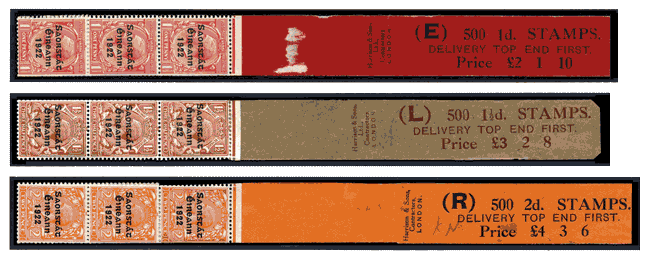
Reduced Handling Charge
The handling charge was reduced from 2d to 1d per 500 stamps on 7 July 1924. The printing contract had passed to Waterlow on 1 Jan 1924, but some Harrison rolls were still in stock and were amended in manuscript, subtracting 1d from rolls of 500, and 2d from rolls of 1,000.

(G): £1.1.0 to £1.0.11
Next: Kermode Rolls